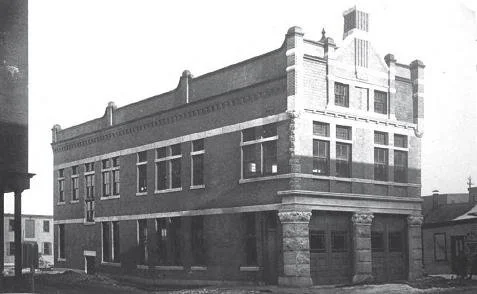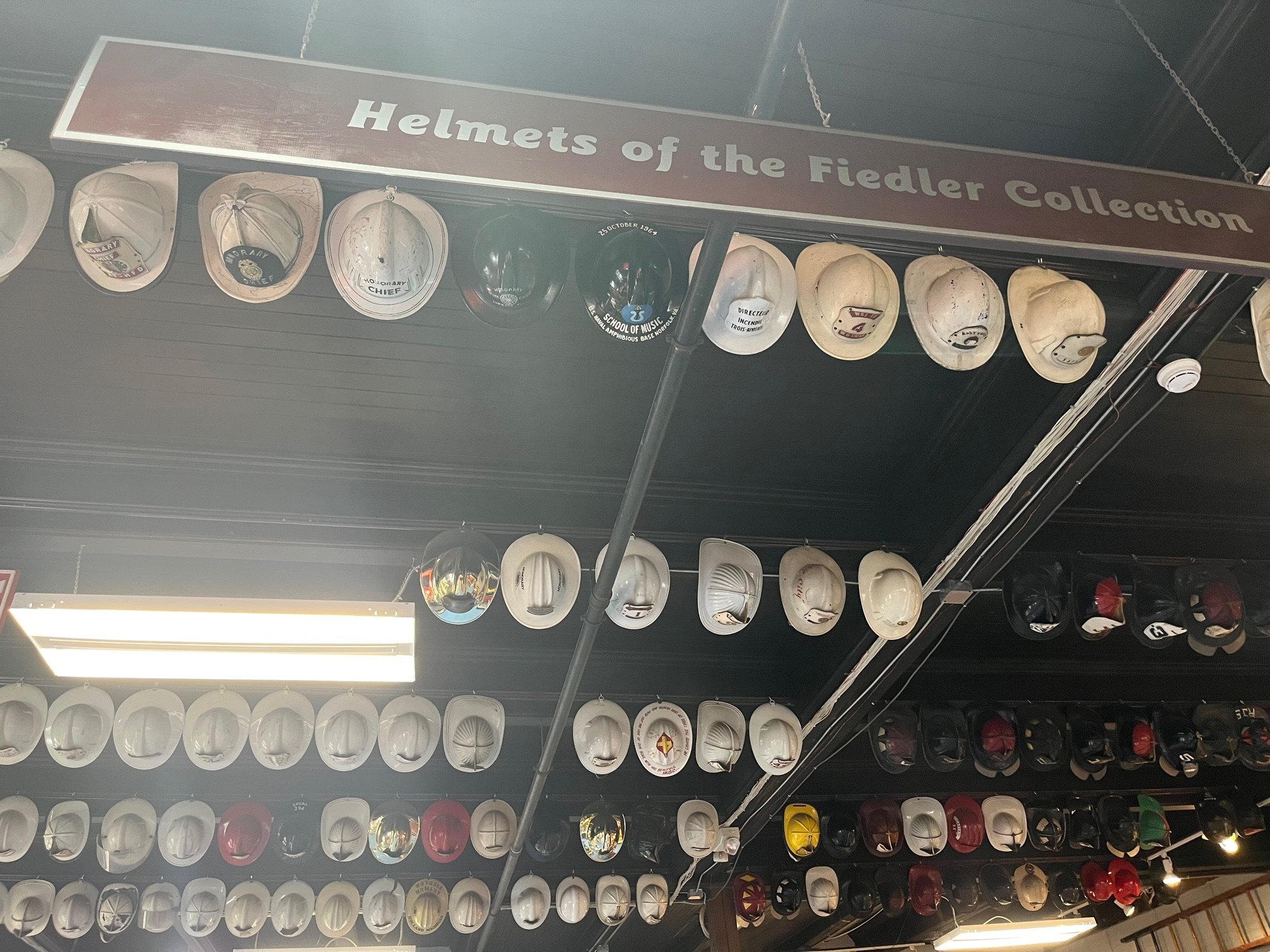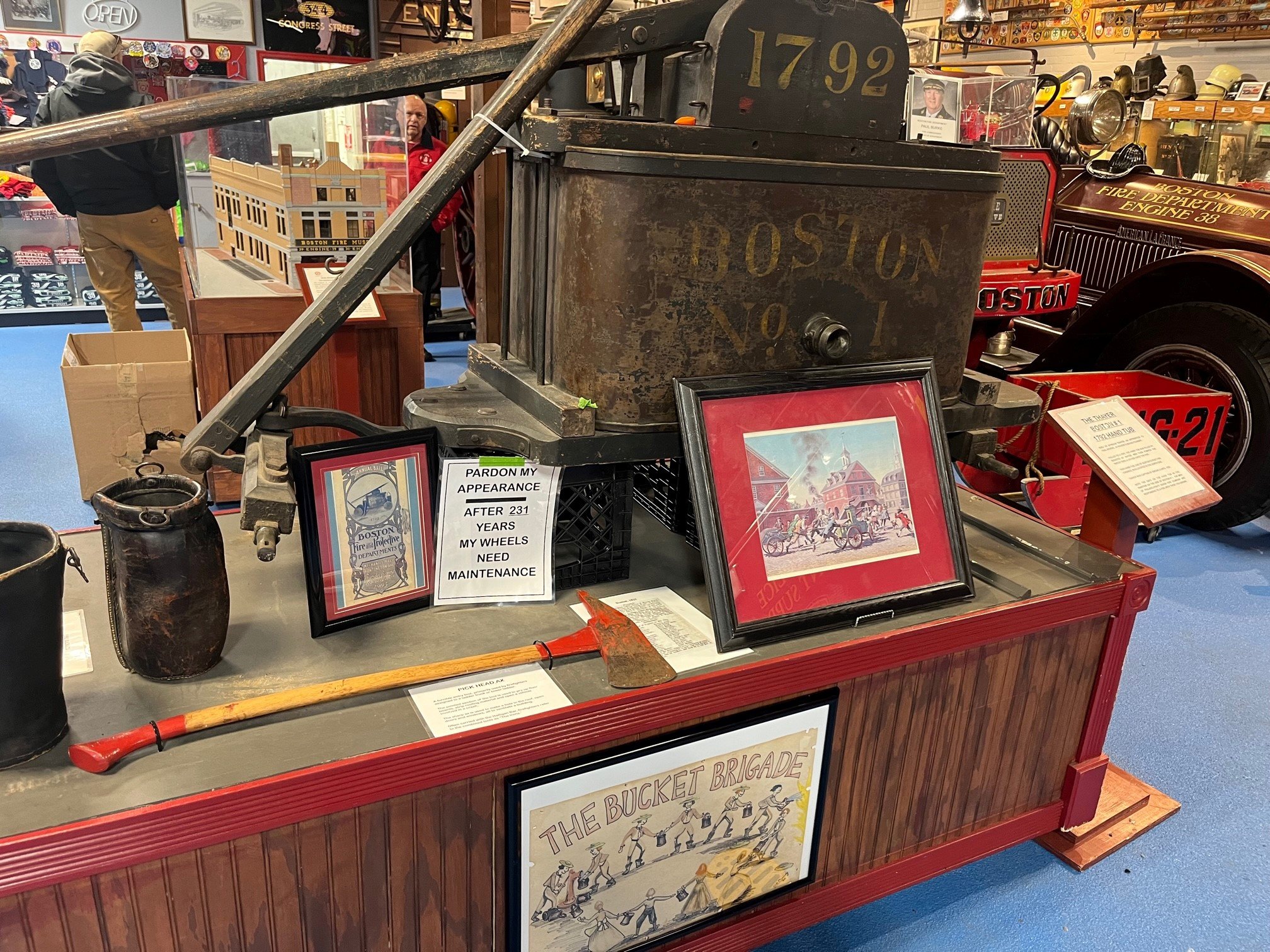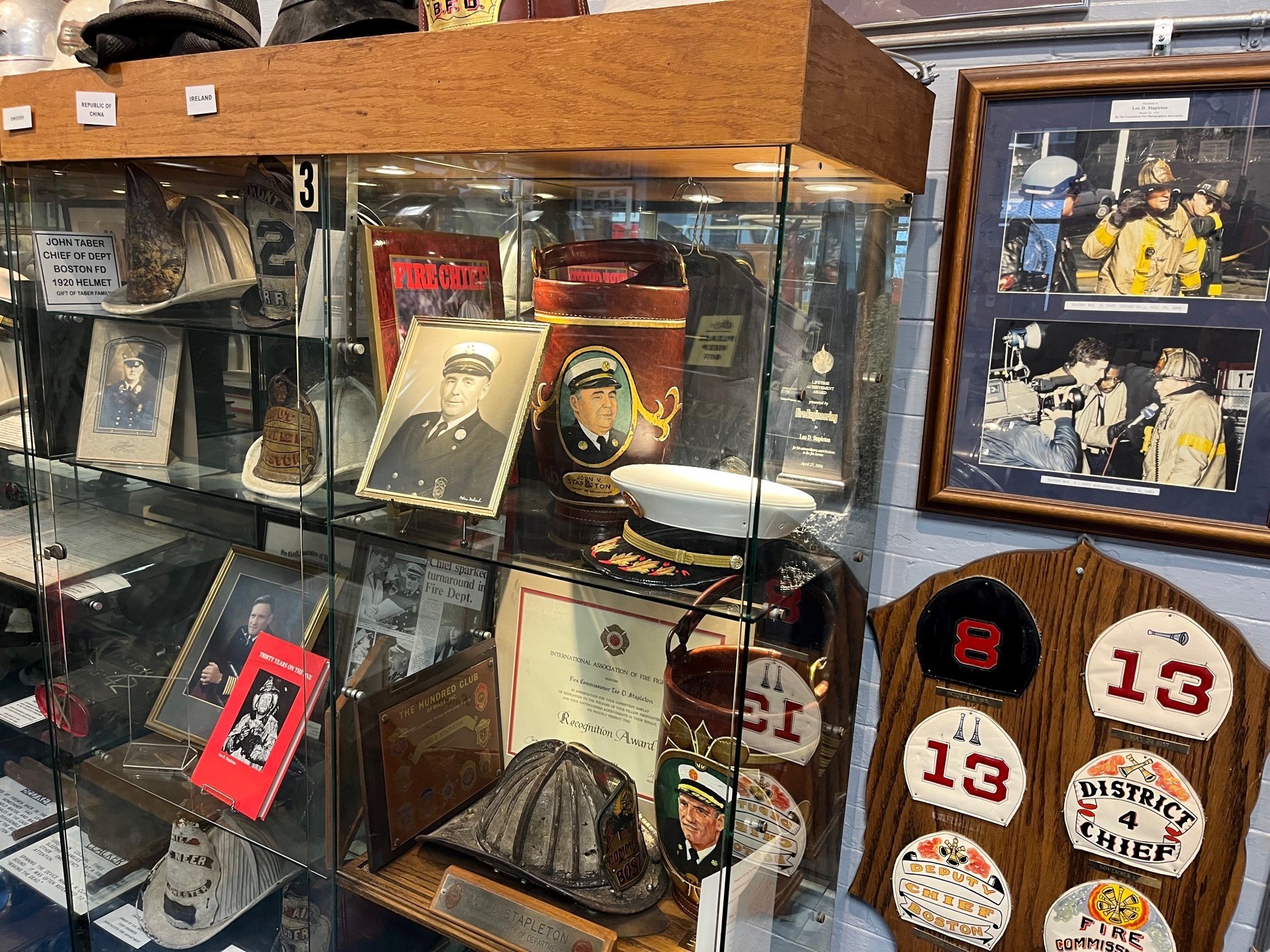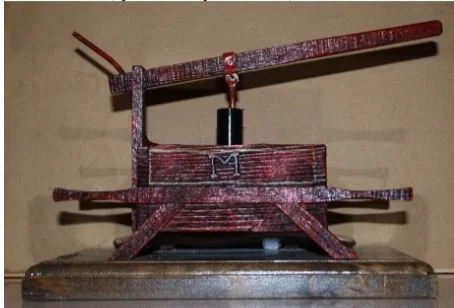
Welcome to the Boston Fire Museum self guided tour. Match the pictures up with facts of the exhibits.

The Cocoanut Grove Display
Occurred November 28, 1942 on Piedmont St., Bay Village
Death toll: 490; Injured: 166; Approximately 1000 patrons
Third highest loss of life fire (building) in US history, after WTC (9/11) & and; Iroquois Theatre (Chicago) 602 killed in 1903
Fire started in Melody Lounge in basement. Busboy lit a match to replace a lightbulb. Moments later, ceiling decorations started to burn. Panicked patrons headed for the revolving door, which quickly became jammed.
A locked exit door at the top of the stairs from the Melody Lounge prevented patrons from escaping, as well as not allowing the fire to vent to the outside atmosphere.
Many fire safety improvements implemented after the fire: flammable furnishings, inward opening exit doors, locked exit doors, revolving door.

The History of the building located at 344 Congress Street in Boston
Firehouse opened on May 18, 1891, Engine 38 & and; Engine 39
Designed by City Architect Harrison Atwood.
Two steamers, each with two horses
Two hose wagons, each with one horse
Stable area had 6 horse stalls.
Wood floor and ‘Dutch’ apparatus doors
Watch desk was not enclosed, only a brass railing
Three pole holes: one each in front room on left & right; third pole in Dormitory area (now is covered by plywood)
Original stairs to 2 nd floor were in corner where the red-door storage closet is now (near bathroom).
In 1897 Engine 38 got a self-propeller, Engine 39 converted to 3-horse hitch, both hose wagons went to two-horse hitches, stable area enlarged to 7 horse stalls.
Firehouse of Ladder 18/Water Tower 3 built in 1902 on Pittsburgh St (now Thomson Place) (50 yards away)
Horse stalls removed in 1917. All apparatus had been converted from horse-drawn except for E-38’s steamer.
Stairs (current) to 2nd floor installed. Originally, last 3 steps at top turned right to enter Day Room or continue up to 3 rd floor
Pole hole on left front discontinued. Kitchen moved from 3rd floor (attic) to 2 nd floor, 3 rd pole placed in kitchen corner.
In 1979, Transportation Museum acquired the building, later dedicated it: “Arthur Fiedler Fire Museum”, honoring the famous Boston Pops conductor, a noted fire buff/“spark”, who owned several pieces of antique fire apparatus. The Fiedler
Fire Museum never opened to the public, abandoned in 1982. The Boston Sparks Association was granted the deed on May 19, 1983. (A Museum of Fire must operate here)
The building was added to the National Register of Historic Places on September 3, 1987.

The Model of the Firehouse
Companies in the Fire House
Engine 38 (1891-1947)
Engine 39 (1891-1977)
Ladder 8 (1952-1953
Ladder 18 (1953-1977)
Built by late District Fire Chief John Vahey, who was appointed to Engine 39 on December 5, 1945.
The model shows the building is a ‘Truss’ building, with 5 large trusses in the attic, with poles going through the second floor to hold the second floor ‘up’. Therefore, no supports on first floor. The second-floor hangs from the roof.
Horse stalls at rear of 1 st floor (in line with current column.)
with the original 6 horse stalls.
Watch desk with brass railings.
At top of (old) stairs on 2nd floor, turn right to Captain’s Room, (in the big room where rostrum is now).
At top of stairs on 2nd floor, turn left to Lieutenant’s Room. (now-Directors Room) Wash room/showers off rear corridor.
Hay loft located where the kitchen is located now.
Dormitory in mid-section of 2 nd floor. (Check rub marks on floor in big room)
Day Room on 2 nd floor same as Front Room now.

Engine 28’s Self-propelled Steam Engine
Built in 1897 at Manchester, NH, Locomotive Works, in Manchester, NH. (trade-name “Amoskeag”), Serial # 727.
Double Extra-First Class steamer, rated at 1350 gpm
Kept hot in firehouse 24x7, pipes from basement furnace came up thru wood floor and connected to steamer.
Needed 90 lbs of steam move. Had studded wheels.
Moved slow, only 5-10mph, made lots of noise.

Arthur Fiedler Helmet Collection
Famous ‘Boston Pops’ conductor 1929-1979 (b. 1894, d. 1979
Had a great interest in firefighters and firefighting
When Pops traveled, local chiefs awarded helmets & badges
Collection donated by Fiedler family in 2005 (approx.)
Many photos of Fiedler at Boston fires standing with the chief
Collection of Fire Department ID cards from across nation.
He had BFD Placard and a Department radio in personal car.

1792 Thayer Hand-tub
Built by Ephraim Thayer, an apprentice of Paul Revere, a coppersmith, metallurgist and caster of church bells.
Built at Thayer’s shop on Washington St., South End, near Tufts Medical Center
Pulled by hand and could be placed near the fire
Bucket brigades would form, dump water in the tub, pass the buckets back, and 2/4 men on each end would pump, discharge from the side connection. Leather hoses w/ rivets.
The Thayer was traded among volunteer fire companies for many years. It was reacquired approx... 20 years ago.
It is not the first ‘fire engine’ in Boston. The first engine’ was in 1678, hand-carried, carpenter Thomas Atkins in charge.
Leather fire buckets used in the bucket brigade

Abe Lincoln steamer
Built in 1882 at Manchester, NH, Locomotive Works, in Manchester, NH. (trade-name “Amoskeag”), Serial # 578.
Was a demonstrator for Amoskeag for 21 years.
Originally horse-drawn, bought by Boston FD in 1903.
Extra First-Class steamer, rated at 1000 gpm
Assigned to Engine 26, on Mason St., Downtown 1903-1909.
Used as a spare from 1909 to 1918.
Christie Front-Drive 4-cyclinder gas engine placed in 1916.
Assigned Shop # 113T.
Assigned to Engine 50 in 1918 when E-50 was organized.
Assigned to Engine 38 in 1925 when Self-Propeller steamer in this firehouse was placed out of service.
Was Engine 38’s pump for 1 year until a 1926 motor engine.
Became a spare again and used to thaw equipment and hoses at winter fires.
On display at BFM since 1984.
Firebox with flickering light meant to show ignition of coal.

1851 Washington #5 Hand-tub
Built by Jucket and Freeman of Pawtucket, RI.
Sold several times, bought by City of Charlestown in 1859.
Placed at the source of water (reservoir, cistern, pond, etc.)
Pulled by ropes by a company of at least 20 men.
The yoke was used to align the pulling ropes and to turn the front wheels, last 4 men using the handles on the yoke.
Hard suction hose (“squirrel-tail”) stored in long, round cylinder at top of engine, connected at lower rear of hand-tub.
Discharge at front of hand-tub, below the builder’s plate.
The two long, gold-colored, bars at top swing down to either side of engine. The bars are called “brakes”. 15/20 men per side were needed to pump ‘up and down’ for as long as they could sustain the action. Another set of 30/40 men then “took a brake”, so the term we now use to stop working “take a brake” in those days actually meant to ‘go to work’.
No water is stored inside the ornate wood ‘tub’ area of the engine. The inside consists only of a bellows and piping.

Stapleton Collection (in Display Cases)
Collection of items donated by the Stapleton family, in honor of Chief of Department John V. Stapleton (COD 1950-1956) and Fire Commissioner/Chief of Department Leo D. Stapleton (Comm/COD 1984-1991)
Fire buckets with likeness of John & Leo painted on side.
5-gold band Class A uniform jacket and uniform cap of Leo.
Many award certificates, plaques, photos, keepsakes.

Why is the firehouse here?
The firehouse is located in the former “Wool District”. All the brick buildings surrounding the firehouse were wool warehouses, many built in 1880’s. Significant fire load.
Boston Wharf Co. owned the buildings. A major investor of BWC was English royalty, who desired fire protection.
The area was cut off from other areas of city by the Fort Point Channel and large railroad yards with any tracks and sidings.
The bridges over the Channel were opening/closing to oceangoing freighters until the late 1950’s, principally to Domino Sugar, near where the Gillette plant is now.
Congress Street, after A Street, had thirteen sets of railroad tracks to cross to get to B Street. Gates often closed off tracks
The closest land fire company that did not have to cross a bridge or railroad track was Engine 15 at West Broadway and Dorchester Avenue (where Broadway MBTA station is.)

Memorial Corner
Line of Duty plaque, showing members from 1852 to 2014.
Vendome Memorial, showing 9 FF’s (1972)
Merrimac St., showing 6 FF’s (5 from this house) (1898)
Hoseman Thomas Devney (E-39) (fell thru pole hole) (1914)
Captain Edward Humphreys (E-39) LODD (1937)
Provisional Military Substitute Patrick Cady (LODD) (1946)

The First Fire Engine
First ‘Fire Engine’ in North America. Arrived from England in 1678. Carried by hand, 3ft long, 18in. wide, 1-man pump, small tub, flexible hose. Thomas Atkins, carpenter, in charge of company of 12 men paid to maintain the engine and put out fires. Kept at ‘Ye Prison’, present-day Court St., near Old State House.



